Hearthstone’s different game modes, explained

Hearthstone is actually ten games in a trenchcoat.
Okay, maybe not. But the truth is that the original game launched with only two playable modes — Constructed and Arena — and over the years, that number has increased to a non-trivial ten.
Having ten different game modes — although to be fair, some of them are simple rules variations over the same mode — is definitely a lot, and can be pretty overwhelming for a new player.
What exactly is contained within that mysterious wooden box? What are all of the different game modes that Hearthstone has to offer, where to find them, and how to decide which one you should try? That is the enigma we are about to solve!

Hearthstone (also called “Constructed”)
The main mode, the star of the show. It is a little weird to have a button called “Hearthstone” within the game of Hearthstone, since that would imply that all the other modes are not Hearthstone — but that’s neither here nor there. To make things less complicated, we’re gonna call that mode “Constructed” from here on — that’s the term one uses to talk about card games where you build decks of cards from your own collection and use them to play, which is the defining feature from this mode, and what separates it from most others.
Constructed is a PVP-focused game mode where you go out against another player, using a deck of cards. Each card represents a minion, a spell, a weapon, or something similar. You use those tools to defeat your opponent’s own minions, and attack them directly, reducing their health to zero in order to win. As you win games, you climb a ladder, which determines your rank.
Although this is the “main” Hearthstone mode, it’s actually not the mode I’d immediately recommend to someone new to the game. Over the years, the client has received lots of other modes that are much more “newbie-friendly,” and which we’re going to talk about later.
Regardless, within Constructed, there are four variations: Standard, Wild, Classic, and Casual.

Standard
The main variation of Constructed Hearthstone, “Standard,” is by far the most important and popular. It’s the one the pro players will play in tournaments, it’s the one streamers will stream, it’s the one that most meta reports will be reporting the meta on. The word “Standard” is there for a reason!
The key thing to know about Standard is that it only uses cards from the Core Set — the evergreen set that will always be there for you (once you earn access to those cards, you’ll never lose it, even if the cards themselves get changed in the future) — as well as the last two years of expansion sets. Every year, those sets “rotate” — three expansions from three years ago are no longer valid in Standard, and we must wait until three new expansions are released within the current year.
Keeping up with Standard Constructed Hearthstone will invariably demand some effort and investment. You’ll need to do your dailies and weeklies diligently if you don’t want to spend any real money — and even then, you might still want to take advantage of cheaper bundles and promotions when you get the chance.
No words minced: it’s sort of a hardcore experience, and not exactly one indicated to those who just want to dabble into Hearthstone casually. The feeling of getting crushed by meta decks over and over is not a good one, so you should only brave these waters if you mean to keep up with the storm!

Wild
This is the mode where anything goes: any card you’ve ever collected is still valid (unless it’s been strictly banned, which is very rare). Good news, right?!
Well, the bad news is: don’t expect balance. Balancing Wild is, honestly, an herculean effort. It’s a far more niche mode than Standard, and most players who decide to play Wild are willingly accepting that the enormous variety of cards available in it will enable some very, very broken combos. In some situations, games might get decided as early as turn three or four, if a player manages to get lucky and draw all the parts of their crazy combo!
This is easily the least newbie-friendly mode in all of Hearthstone. It’s one for the enthusiasts, for sure.

Classic
A blast from the past! This is Hearthstone from a very specific era, frozen in time: June 2014, before the game received its first expansion, Curse of Naxxramas. It’s not at all unlike how World of Warcraft Classic compares to “retail” WoW, with all of the changes and additions leading up to Shadowlands.
The truth is that the game was very different then: it had much simpler mechanics. A minion with Charge and Divine Shield was a big deal; a minion that could buff another minion with +1/+1 was good enough to see tournament play. I admit that I do nurture some nostalgia for that era. If you do too — especially if you’re a returning player who used to play in those days but didn’t keep up with the evolution of the game — Classic might be right up your alley!

Casual
This is a “sandbox” mode of sorts. It’s the one a lot of players use to test out their decks, to see them in action without really caring if they win or lose the game. Why? Because games happen in a vacuum; there is no ladder, there are no rankings, there are no stakes for winning or losing. It’s… casual. You’re matched up against another player who also picked Casual, and the two of you duke it out, with whichever decks you want.
In theory, this is not unlike the Quick Play mode found in games like Overwatch or Heroes of the Storm — but do not be mistaken. Whereas Quick Play in Overwatch is popular enough that it could even become the main mode someone plays there, Casual mode is far from a big deal in Hearthstone. Most players don’t even acknowledge its existence.
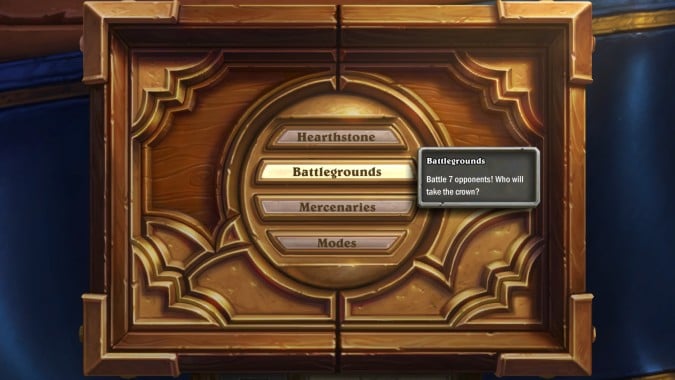
Battlegrounds
Alongside Standard, this is the other very popular mode! Unofficial data from before the release of Mercenaries showed that the two most popular modes in Hearthstone, with roughly the same amount of players as one another, were Standard and Battlegrounds. These are also the ones most people will be talking about, making memes about, and the ones you’re most likely to see someone streaming. With the Year of the Hydra, we’ll also see a new progression system and Seasonal play, making it worthwhile to continue to play for a long time to come.
Battlegrounds is what they call an “auto-battler:”a genre of games where you place down units — worrying about things like positioning and order of attacks, as well as synergy between their abilities — and then watch as they battle by themselves, without input from you. Once one side defeats the other, that round is over, and you can place your minions again, as well as buy, sell, and upgrade your minions to make them stronger for the next bout.
Games happen on a lobby of eight players, and as players lose all of their health points, they get eliminated; which means that, sort of like in battle royale games, you need to aim to survive. If you end up among the top four survivors, it already counts as a win (but finishing third, second, or first earns you progressively more rating points, which further increase your rank).
You use cards, but you don’t have a deck: all players start on equal conditions, with three gold to spend, and nothing else. The “bartender” randomly offers you a selection of minions you may purchase, and later on you might also spend gold to refresh the tavern, changing up those minions. You may also spend your gold upgrading your tavern: a higher tier tavern offers better minions than the previous, and the tavern has six total levels. The minions on tier six are considerably more powerful than the minions on tier one.
Battlegrounds is easily the one mode I’d recommend for someone who’s new to Hearthstone and wants to dabble into it in a low-stress, pretty casual manner. This game mode is complex enough to warrant a good amount of strategy, but at the same time, it’s very easy to learn and you should be able to quickly grasp the rules, and the general ebb and flow of matches. The fact that it requires no previous investment in buying packs of cards, and as such, all players start on equal footing for the most part, is also a huge plus.

Mercenaries
The new kid on the block! Mercenaries is a hero collector mode with simple RPG-like mechanics. Unlike Constructed and Battlegrounds, it’s mostly PVE-focused — but it does include a PVP-mode as well.
In terms of scope and complexity, Mercenaries is trying to be a very different game from most other modes in Hearthstone. It operates similarly to many mobile games where you collect heroes and work to improve them, upgrading their abilities and equipment, earning new portraits (skins) for them, etc.
Gameplay is also much simpler than any other mode in Hearthstone: most new players should be able to pick it up very quickly. And if you’re playing it as a PVE experience, it also has the advantage of being very relaxed, allowing you to take your time with no turn timer putting pressure on you.
The gameplay mechanics are a tad simplistic compared to the other modes of Hearthstone, to the point where it might be simultaneously appealing to those who are looking for a very relaxed and casual experience, and off-putting to those who are looking for something more tactical and complex. With the Year of the Hydra, Mercenaries will receive balance passes on the X.4 patches, meaning that you can predict when the meta will change and plan accordingly. Regardless, it’s very easy to jump into Mercenaries, play through the tutorial, and give it a try, to decide for yourself if this mode is for you or not!

Other Modes
Everything else goes in here — but there is still a lot to see. Four different modes are present under this button at the moment: Arena, Solo Adventures, Duels, and Tavern Brawl. That’s nothing to scoff at! A very considerable portion of player’s experiences in Hearthstone will be found within those “other” modes. So let’s discuss each of them.

Arena
Back in my day, when we wanted a break from “normal” Hearthstone, we played Arena! Uphill in the snow, both ways! And we liked it! Kids these days are spoiled for–
Ahem. Arena is the original “alternative” PVP mode that still has its dedicated, die-hard fans. The gameplay itself uses the exact same rules as Constructed Hearthstone, but there’s a key difference: before each Arena “run,” you will draft your decks, from selections of cards that are randomly offered to you. You don’t rely on your existing collection of cards at all. The game simply asks you to pick a card from three; you pick it, and it’s now part of your deck (for that run). Then you repeat that process 29 times, and you walk away with a Hearthstone deck of 30 cards — albeit you may also break certain rules, such as having more than just two copies of each card, something that you can’t do in Constructed.
In theory, that would mean that each Arena run is “free,” since you conjure up your deck from thin air each time, and you don’t need to bring your own cards — but the truth is that starting an Arena run costs a Tavern Ticket. You can get one with in-game gold or with real money, though you can also find a few of these in bundles, or as rewards by leveling up in the rewards track.
Arena games end up being a little different from Constructed games because decks have much less synergy. You’ll see fewer combos, and you’ll see a lot of turns where a player is trying to do one of these two things: play an even bigger minion than the other player, in order to establish dominance in the board, or casting some big spell or minion effect to clear their opponent’s board. Still, even though games might end up playing differently, this is an excellent mode to get new players familiarized with Hearthstone mechanics, and slowly grasp how to play.
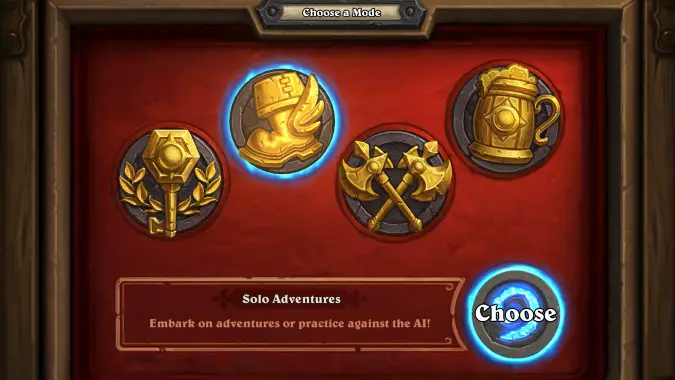
Solo Adventures
These are PVE-focused, and come in a wide variety of forms. The ongoing one is Book of Mercenaries, where you are must tackle a series of eight challenges of increasing difficulty, using predetermined heroes and decks. Most of these exist as story-based little solo adventures where you’ll learn more about a character — both acclaimed legends from Warcraft lore and newcomers from Hearthstone itself.
Past Adventures are still available for purchase, and still offer rewards. Of particular note is Dungeon Run, a fan-favorite that became arguably the most successful PVE format Hearthstone has ever seen — definitely worth a try.
Within the Solo Adventures menu, besides all of those adventures new and old, you’ll also find the Practice button, where you can simply battle the AI using any Constructed deck you want. Useful if you just want to test out a card interaction, not necessarily against a human player. But this is a lackluster experience if you’re craving challenge, be warned: the AI is not very good.
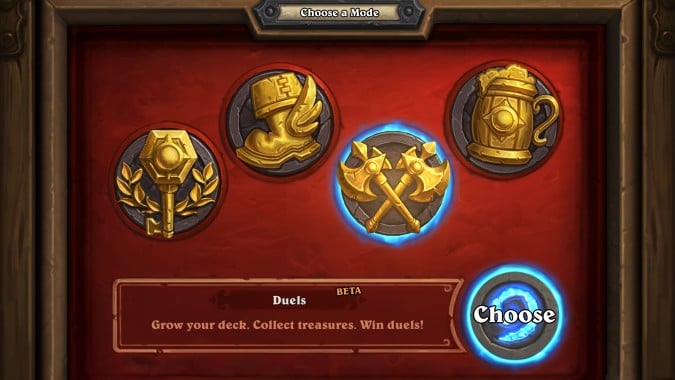
Duels
Duels is an “experimental” PVP mode that functions like Constructed and Arena, but with ideas taken from the PVE Dungeon Run mode. It was released without much hype or fanfare, and as of the time of this writing, it’s still in Beta.
This is probably the most niche of all Hearthstone modes. It has its die-hard fans, and its own meta, which is completely separate from the Constructed meta, since things like Hero selection and Treasure selection are as likely to affect the outcome of matches as the actual cards in your deck — if not more.
In fact, Duels is possibly the most meta-oriented of all Hearthstone modes: since there are three different variables (deck, Hero, Treasure), the variance in power among them is much higher, which means that certain combinations will naturally be much stronger than others. So if you’re planning on trying out Duels, you kind of need to follow the meta, or you won’t get too far at all.
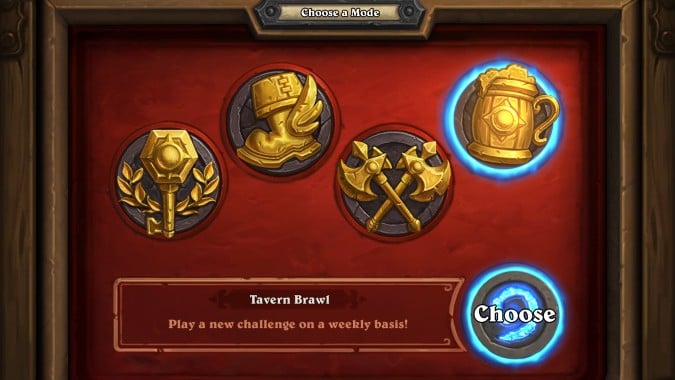
Tavern Brawl
Although it’s the last one on the list, this is the first mode I’d recommend to players new to Hearthstone, alongside Battlegrounds.
Tavern Brawl is a very casual mode that uses the same structure as Constructed Hearthstone — but the rules are completely different, and will vary wildly from week to week. Each week offers a brand-new type of challenge. The vast majority of them are PVP-focused — every once in a while there will be a PVE one, or one where you team up with another player to tackle a challenge that requires input from both of you to be beaten — but still very relaxed, since there are no real stakes. You only need to win once, and you’ve got a whole week to do it.
Playing Tavern Brawl should get you familiarized with regular Constructed rules, albeit with a twist. The low stakes environment alleviates the stress one might find upon jumping into PVP. Games can be fun, and once you get your weekly win, you’ll earn a cards pack that can be used in Constructed. No reason not to try it, really!
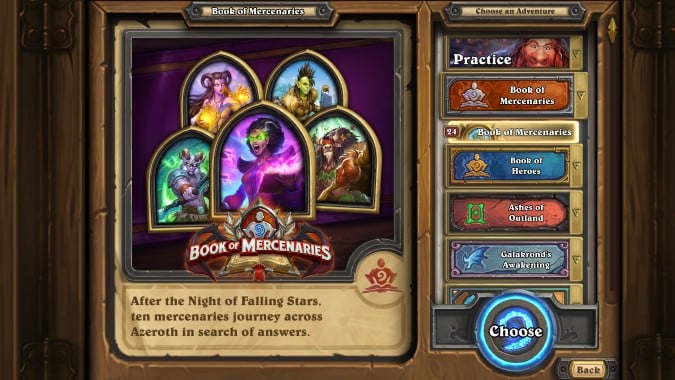
These are all the ten modes that Hearthstone currently has, and hopefully you’ll have a better understanding of them, and find the one that is best suited to you.
There seems to be one for every type of player: collectors, hardcore players looking to hone their skills and reach Legend ranks, casual players looking to dabble into something silly and fun every once in a while, players who want PVE challenges with funny stories, players who want cutting-edge PVP where you’ll hate your opponent’s guts when they destroy your carefully-crafted plans in a single turn with their crazy combo! This little mystery box has it all.
Originally posted 10/15/2021. Updated 4/7/2022.
Please consider supporting our Patreon!
Join the Discussion
Blizzard Watch is a safe space for all readers. By leaving comments on this site you agree to follow our commenting and community guidelines.
 @harmonicstrike
@harmonicstrike




